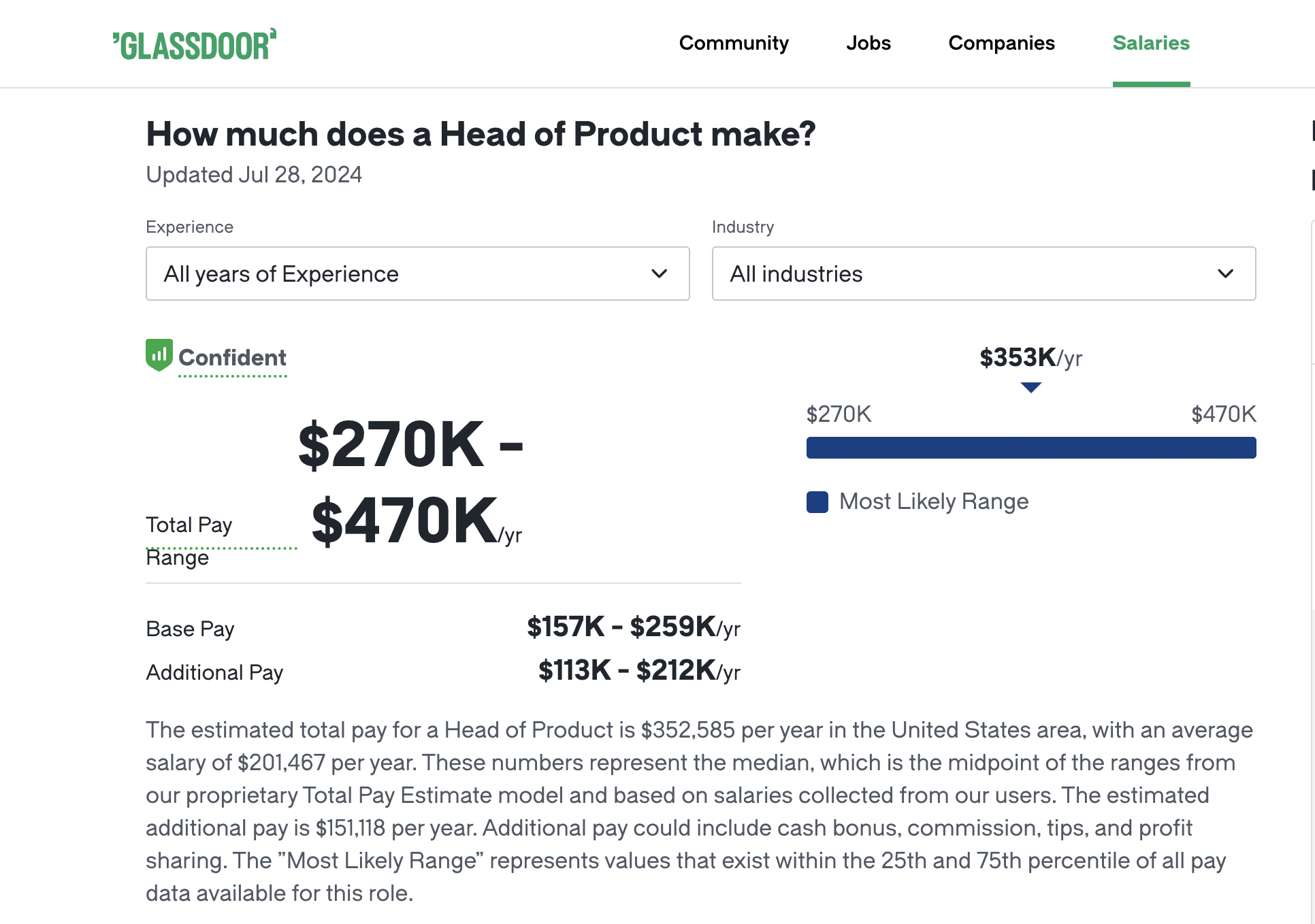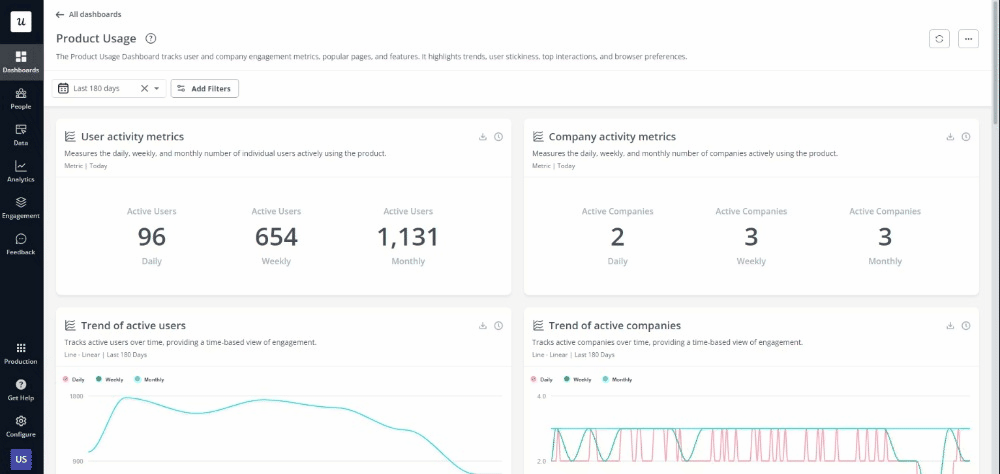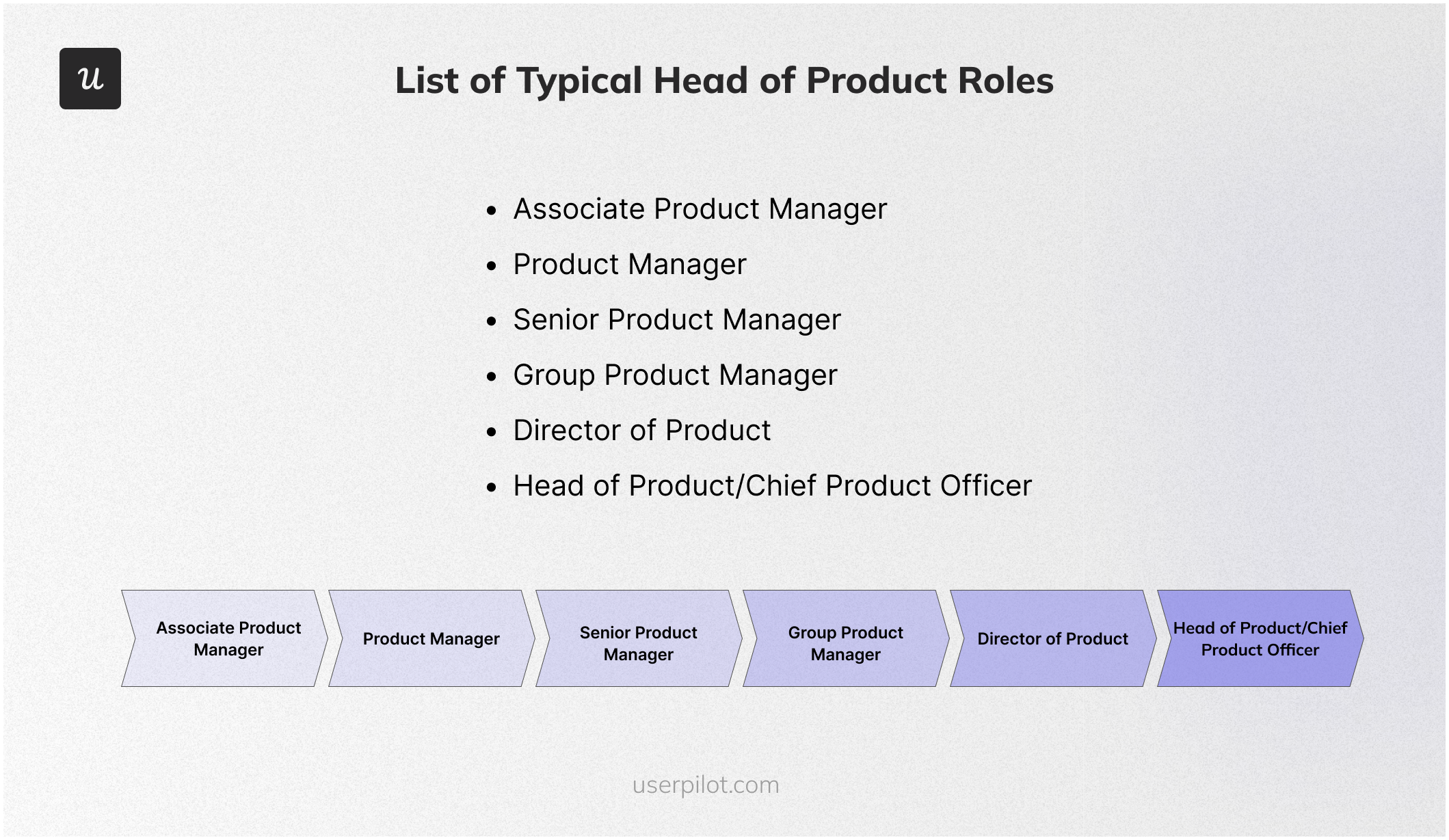![Head Of Product Salary [+ Resources to Advance]](https://blog-static.userpilot.com/blog/wp-content/uploads/2024/08/Head-Of-Product-Salary.png)
Understanding the salary range for head of products is crucial whether you’re entering the field or looking to advance your career.
In this guide, we’ll provide an overview of typical head of product salaries, explore factors that can influence earnings, and share valuable resources to help you progress in your career.
Let’s get started!
Try Userpilot Now
See Why 1,000+ Teams Choose Userpilot

TL;DR
- A head of product is a leadership role responsible for overseeing the development and management of a product or a portfolio of products within a company. They play a crucial role in defining the product strategy, setting the product vision, and ensuring the successful execution of product initiatives.
- Based on data from Glassdoor, the estimated total pay for a head of product in the United States is $352,585 per year. This includes a base salary of $201,467 per year and additional compensation of $151,118 per year (which may include bonuses, stock options, and other benefits).
- Here are some best practices for excelling as a head of product, focusing on actionable strategies rather than skills or qualifications:
- Embrace a customer-centric mindset: Always prioritize understanding and advocating for the customer’s needs. This means actively seeking feedback, conducting user research, and ensuring that every decision aligns with delivering value to the customer.
- Foster a strong product culture: Cultivate a culture where everyone in the organization values the customer, understands the product vision, and is empowered to contribute to its success. Encourage open communication, collaboration, and a willingness to experiment and learn from failures.
- Prioritize ruthlessly: With limited resources and time, it’s crucial to focus on the most impactful initiatives. Learn to say “no” to less important features or projects and ensure that your team is working on the things that will move the needle most.
- Communicate effectively and transparently: Clearly articulate the product vision, strategy, and goals to your team and stakeholders. Be transparent about progress, challenges, and learnings. Effective communication fosters trust, alignment, and buy-in from all parties involved.
- Be data-driven but not data-bound: Use data to inform decision-making, but don’t let it be the sole driver. Balance quantitative data with qualitative insights and intuition to make well-rounded decisions.
- Embrace experimentation and iteration: Don’t be afraid to try new things and learn from mistakes. Encourage experimentation and iteration to continuously improve the product and stay ahead of the competition.
- Looking into tools for heads of product? Userpilot is an all-in-one product platform with engagement features and powerful analytics capabilities. Book a demo to see it in action!
What is a head of product?
A head of product is a leadership role responsible for overseeing the development and management of a product or a portfolio of products within a company. They play a crucial role in defining the product strategy, setting the product vision, and ensuring the successful execution of product initiatives.
Head of product’s main responsibilities
Key responsibilities of a head of product typically include:
- Defining product strategy: Conducting market research, gathering customer insights, analyzing competitor landscapes, and identifying market opportunities to shape the overall product strategy.
- Setting product vision: Articulating a clear and compelling vision for the product that aligns with the company’s goals and resonates with target users.
- Leading product teams: Managing and mentoring a team of product managers, product owners, and other product professionals, fostering collaboration and driving high performance.
- Prioritizing features: Working with stakeholders to prioritize feature development based on market needs, user feedback, and business objectives.
- Collaborating with cross-functional teams: Partnering with engineering, design, marketing, and sales teams to ensure smooth product development and successful launches.
- Monitoring product performance: Tracking key metrics and analyzing user data to assess product performance and identify areas for improvement.
How much does a head of product make?
Based on data from Glassdoor, the estimated total pay for a Head of Product in the United States is $352,585 per year. This includes a base salary of $201,467 per year and additional compensation of $151,118 per year (which may include bonuses, stock options, and other benefits).
However, the salary range can vary widely with the total pay range between $270,000 and $470,000 per year. For example, some companies like Amazon and Google are reported to pay their Heads of Product upwards of $500,000 per year.

Head of product career path
Here’s a breakdown of a typical career path for a head of product. However, do note that the years of experience for each role are approximate and can vary depending on individual career paths and company structures. Some individuals may progress faster than others, while others may choose to specialize in a particular area of product management, such as growth, data, or platform products.
1. Associate Product Manager (0-2 years): This entry-level position is the starting point for many aspiring product managers. Associate Product Managers (APMs) typically work under the guidance of experienced Product Managers, assisting with tasks like market research, competitive analysis, feature prioritization, and user feedback collection. They gain hands-on experience with product development processes and learn the fundamentals of product management.
2. Product Manager (2-5 years): Product Managers (PMs) own a product or feature set and are responsible for its overall success. They define product strategy, prioritize features, gather requirements, and work closely with engineering, design, and marketing teams to bring the product to market. PMs also track product performance metrics and use data to inform decision-making and drive continuous improvement.
3. Senior Product Manager (5-8 years): Senior Product Managers (Sr. PMs) have more experience and typically manage a larger product or a team of PMs. They are responsible for developing and executing complex product strategies, leading cross-functional teams, and driving significant business impact. Sr. PMs often have more autonomy and influence within the organization, and they may also mentor and coach junior PMs.
4. Group Product Manager (8-12 years): Group Product Managers (GPMs) oversee a portfolio of products or a large product area. They set the overall vision and strategy for their product group, manage a team of PMs and Sr. PMs, and are responsible for achieving ambitious business goals. GPMs often interact with senior executives and stakeholders, and they play a key role in shaping the company’s product direction.
5. Director of Product (12-15+ years): Directors of Product (DPMs) are senior leaders who manage a large product organization or multiple product groups. They are responsible for the overall product strategy, roadmap, and execution across the organization. DPMs collaborate with other C-level executives to set company-wide product priorities and ensure alignment with business objectives. They also play a crucial role in developing and mentoring the next generation of product leaders.
6. Head of Product/Chief Product Officer (15+ years): This is the pinnacle of the product management career ladder. Heads of Product (HoPs) or Chief Product Officers (CPOs) are executive-level leaders responsible for all product-related activities within a company. They report directly to the CEO and are accountable for the success of the company’s entire product portfolio. HoPs/CPOs set the overall product vision, define the product strategy, and lead the company’s product culture. They also play a critical role in attracting and retaining top talent, and they are often involved in investor relations and fundraising.
Best practices to be a great head of product
Here are some best practices for excelling as a head of product, focusing on actionable strategies rather than skills or qualifications:
- Embrace a customer-centric mindset: Always prioritize understanding and advocating for the customer’s needs. This means actively seeking feedback, conducting user research, and ensuring that every decision aligns with delivering value to the customer.
- Foster a strong product culture: Cultivate a culture where everyone in the organization values the customer, understands the product vision, and is empowered to contribute to its success. Encourage open communication, collaboration, and a willingness to experiment and learn from failures.
- Prioritize ruthlessly: With limited resources and time, it’s crucial to focus on the most impactful initiatives. Learn to say “no” to less important features or projects and ensure that your team is working on the things that will move the needle most.
- Communicate effectively and transparently: Clearly articulate the product vision, strategy, and goals to your team and stakeholders. Be transparent about progress, challenges, and learnings. Effective communication fosters trust, alignment, and buy-in from all parties involved.
- Be data-driven but not data-bound: Use data to inform decision-making, but don’t let it be the sole driver. Balance quantitative data with qualitative insights and intuition to make well-rounded decisions.
- Embrace experimentation and iteration: Don’t be afraid to try new things and learn from mistakes. Encourage experimentation and iteration to continuously improve the product and stay ahead of the competition.
Best resources for head of products
To excel as a head of product, it’s crucial to continuously learn and stay updated on industry trends, best practices, and emerging technologies. Here are some of the best resources available to help you on your journey:
Best books for head of products
Here are some of the best books for heads of product:
- Inspired: How to Create Tech Products Customers Love by Marty Cagan: This book is a comprehensive guide to building successful products. Cagan, a seasoned product leader, shares his insights and experiences on everything from product strategy and discovery to product development and launch.
- Empowered: Ordinary People, Extraordinary Products by Marty Cagan & Chris Jones: This book is a follow-up to “Inspired” and focuses on how to empower product teams to deliver exceptional results. Cagan and Jones share their framework for building a strong product culture and creating an environment where teams can thrive.
- Escaping the Build Trap: How Effective Product Management Creates Real Value by Melissa Perri: This book challenges the traditional product development mindset and emphasizes the importance of focusing on outcomes over outputs. Perri provides a framework for building products that truly solve customer problems and deliver real value.
- The Lean Product Playbook by Dan Olsen: This book provides a step-by-step guide to building products using lean startup principles. Olsen outlines a practical framework for validating product ideas, building minimum viable products (MVPs), and iterating based on customer feedback.
- Product Leadership: How Top Product Managers Launch Awesome Products and Build Successful Teams by Richard Banfield, Martin Eriksson, and Nate Walkingshaw: This book offers practical advice and insights from experienced product leaders on how to launch successful products and build high-performing teams. The authors cover a wide range of topics, from product strategy and prioritization to team building and communication.
Best webinars for head of products
Here are some excellent webinar resources for heads of product:
- Userpilot Events: We regularly host webinars and workshops on various product management topics featuring industry experts and thought leaders. Our series covers a wide range of topics related to product adoption, onboarding, and user engagement. You can stay updated on our latest events by visiting our events page.
- Product School: Product School hosts live webinars and interviews with product leaders from top companies almost daily. Topics range from product strategy and leadership to user research and data analysis.
- Mind the Product: Mind the Product is a global community of product managers, and their webinars reflect this diversity of perspectives. They offer a mix of practical workshops, panel discussions, and presentations on topics like user research, product strategy, and product leadership. Their webinars often focus on real-world examples and case studies.
- ProductPlan: ProductPlan is a popular roadmapping tool, and their webinars often center around creating and managing effective product roadmaps. They also cover topics like prioritization, stakeholder management, and communicating product strategy. Their webinars are typically geared towards practical advice and actionable tips.
Best blogs for head of products
Here’s a curated selection of blogs providing valuable insights, strategies, and thought leadership for product leaders:
- Userpilot Blog: Our blog features topics like strategies for improving user adoption, increasing feature engagement, and using in-app experiences to drive product growth. You can expect to find actionable insights, case studies, and practical tips for maximizing user satisfaction and retention.
- Silicon Valley Product Group (SVPG) Blog: This blog is a goldmine for product leaders seeking strategic guidance and thought leadership. It features contributions from seasoned product veterans like Marty Cagan, delving into topics like product strategy, team leadership, company culture, and the overall philosophy of building successful products.
- Product Coalition: This Medium publication serves as a hub for diverse perspectives on product management, design, and development. It features articles from a wide range of product professionals, offering a broad spectrum of insights and opinions on various topics relevant to product leaders.
- Inside Intercom: This blog offers a wealth of resources from one of the leading customer communication platforms. It covers a broad range of topics, from building and scaling products to effective marketing, sales, and customer support strategies. It’s a valuable resource for product leaders seeking a holistic view of the product lifecycle.
- Ken Norton’s Blog (Bring The Donuts): This blog features insightful posts from Ken Norton, a renowned product management expert and partner at Google Ventures. He shares his wisdom on product strategy, leadership, and the broader tech industry.
Best podcasts for head of products
Here are some of the best podcasts for heads of product. They cover a wide range of topics, from the latest trends and technologies to practical tips and advice for building and managing successful products.
- Lenny’s Podcast: Hosted by Lenny Rachitsky, this podcast features in-depth interviews with top product leaders from companies like Airbnb, Figma, and Stripe. It covers a wide range of topics, from product strategy and growth to team building and leadership.
- This is Product Management (TIPM) by DISQO: This podcast covers a wide range of product management topics, including user research, experimentation, leadership, and corporate innovation. They feature interviews with industry experts from companies like Shopify, Adobe, PayPal, and more.
- The Product Podcast by Product School: Hosted by Product School, this podcast features interviews with product leaders from top companies, covering topics like product strategy, growth, and leadership. They also offer product management courses and certifications.
- 100 Product Managers: Hosted by Suzanne Abate, this podcast features interviews with product managers from diverse backgrounds and industries. They discuss their experiences, challenges, and successes in building and managing products.
- Product Led Radio: This podcast focuses on product-led growth strategies, where the product itself drives customer acquisition, activation, and expansion. They feature interviews with experts in product-led growth, as well as case studies and practical tips.
Best tools for head of products
Here’s a list of tools that are particularly helpful for heads of product and how they benefit those in this role:
- Userpilot – Best for user research & product analytics: Userpilot allows you to collect in-app user feedback, track user behavior, and analyze how users interact with your product. This enables you to identify areas for improvement, understand user needs, and make data-driven decisions to optimize the user experience.
- ChurnZero – Best for customer success and retention: ChurnZero helps you track customer health scores, identify at-risk customers, and proactively engage with them to prevent churn. This empowers you to take action to improve customer satisfaction, increase retention rates, and drive long-term customer loyalty.
- ClientSuccess – Best for customer onboarding and engagement: ClientSuccess provides tools for creating personalized onboarding experiences, tracking customer progress, and driving the adoption of your product. This helps you ensure that new customers get the most value out of your product, leading to increased satisfaction and reduced churn.
- Amplitude – Best for product analytics and insights: Amplitude provides deep insights into user behavior, allowing you to understand how users interact with your product, identify popular features, and track conversion funnels. This data helps you make informed decisions about product development and prioritization.
- Mixpanel – Best for user behavior analysis and segmentation: Mixpanel allows you to track user events, segment users based on their behavior, and create targeted campaigns. This empowers you to understand different user segments, tailor your product experiences, and drive personalized engagement.
- Asana – Best for project management and team collaboration: Asana helps you organize tasks, track progress, and collaborate effectively with your team. This ensures that projects stay on track, deadlines are met, and everyone is aligned on priorities.
- Jira – Best for issue tracking and agile development: Jira is widely used for tracking bugs, managing software development sprints, and facilitating agile workflows. It helps product teams collaborate efficiently, track progress, and deliver high-quality products on time.
Conclusion
Now that you have a better understanding of the salary range for a head of product position, you can take steps to improve your earning potential.
Consider pursuing relevant certifications, developing your skillset, or negotiating effectively during the job offer stage.
Looking into tools for heads of product? Userpilot is an all-in-one product platform with engagement features and powerful analytics capabilities. Book a demo to see it in action!









